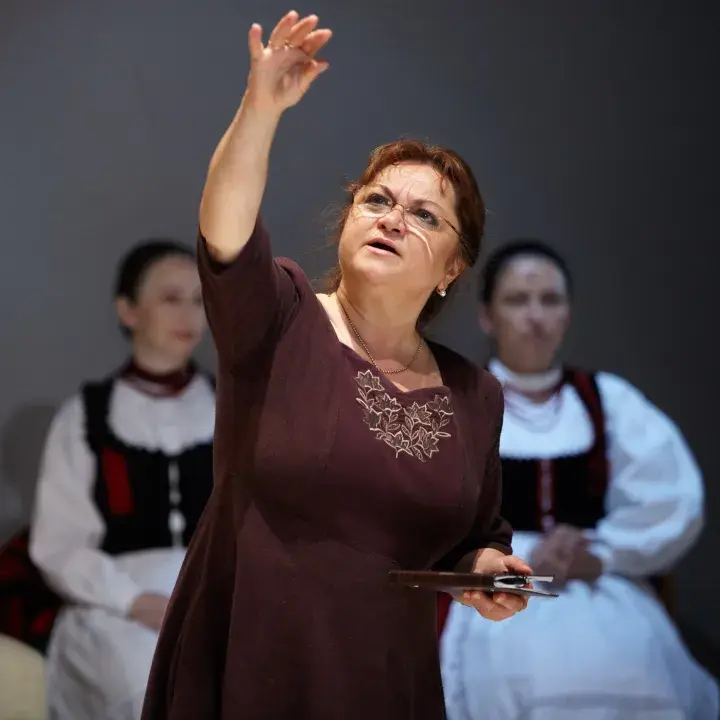The Hungarian Dress Movement and its influence on fashion
Kalotaszeg patterns, Rábaköz motifs, and Matyó embroidery are well-known decorative elements of Hungarian folk art, which became symbols of Hungarian identity after the Treaty of Trianon. Since the mid-1930s, the fashion industry has also increasingly used various folk art motifs to decorate clothes. Fashion columns promoted the Hungarian Dress Movement in picture magazines, fashion shows and film. The movement is based on an earlier, romantic idea of the 19th century, which considered the culture of the peasantry to be the guardian of national characteristics but did not take into account the disintegration of folk culture.
The history of the Hungarian Dress Movement is inseparable from Debrecen. Its most notable representatives - Ferenc Ferenczy, Klára Tüdős and Erzsébet F. Haranghy - were all originally from there. Ferenczy founded the National Committee of the Hungarian Dress Movement in 1933. It organised design contests several times with the intention of harmonising the forms and motifs of Hungarian historical and folk costumes with the fashion of the time. Other artists, such as Teréz Nagyajtay, Juci Tedesco Juci and Ilona Farnadi, also acquired fame through these design competitions.
The costumes were also a huge success abroad; The French fashion magazine Femina, for example, named Budapest as one of the centres of winter fashion alongside Paris and Italy on its cover, and in 1937, Franklin Simon decorated the shop windows of his New York department store with Hungarian clothes, which also had a huge press coverage.
The most prominent representative of the clothing movement was Klára Tüdős, whose work is inseparable from the folk movement. Ms Tüdős hoped to solve the country's social problems with the recovery of the home industry: through her excellent organisational skills and connections, she created well-functioning home industry premises, thereby offering a new opportunity. It was her principle that the embroidery, linen and lace of the clothes of the raw material should be produced, if possible, in its original region. However, she didn't only want to create a living for the peasantry in this way but also to encourage city women to engage in the home industry, which had largely disappeared by her time.
Ms Tüdős considered the traditional or simply beautiful objects of not only Hungarian but also of other traditions integrable into Hungarian culture, and therefore, worthy of being followed or even imitated. In 1936, she opened her own salon under the name "Pántlika" in downtown Pest. She would create exclusive models for the social elite and the art world in her salon. The most famous Hungarian film stars – such as Zita Szeleczky - dressed in her salon, but the women of the Horthy family were also happy to order clothes from her. When designing clothes, Ms Tüdős worked along the lines of the following rule: "A dress should be Hungarian either in material, in form, or in decoration, but never all three at the same time.”
The Association of Social Unions (TESz) organised the first large-scale fashion design competition and fashion show in 1933. A cyclamen-coloured taffeta evening dress was especially popular with its Hungarian lines, cord embroidery decoration, and Matyó embroidery on the shoulders. The dress was designed by Klára Tüdős and presented by the actress Ella Kertész. Not everyone, however, appreciated the innovation of the Hungarian folk motifs appearing on a dress that followed Parisian fashion salons. As some contemporary critiques remarked, "The dress is very beautiful, but except for the Matyó embroidery, it hardly has a Hungarian character" Ms Tüdős' genius lay in just that, though. The future didn't belong to the historicist clothing of the 19th century, reminiscent of ornamental Hungarian gala attires, but to the fresh, wearable and fashionable clothes, which were complemented with elements drawn from folk art. Hungarian motifs aroused international interest, and foreigners also willingly ordered and bought such garments – for example, in Ms Tüdős' salon. In connection with the opening of the salon, a columnist of the Budapest Newspaper remarked in 1937: "No one who has hitherto been reluctant to dress in overemphasised folky clothes should feel averse to these dresses. These clothes are no bungled Hungarianised costumes; these clothes are Hungarian. Their national character lies in their spirit and in their being. This spirit, we dare say, will conquer the hitherto reluctant Hungarian women as well as foreign markets."
Her fashion shows were organised at the Piccadilly Restaurant on Margaret Island, and the show was accompanied by the most famous Gypsy fiddler of the time, Imre Magyari, and his orchestra. Ms Tüdős chose her mannequins from the Opera House: ballet dancers. Elsa Schiaparelli, an Italian fashion designer, and Countess Jacqueline Almásy paid their tribute to her several times.
The director of the Women's Crafts School at Rákóczi Square, László Spolarich, was also among the members of the Dressing Committee. Although the instruction of ethnography was given a prominent role in the curriculum of women's crafts schools, the industrial training could not fully support the movement. These secondary schools taught fashion design at the level expected of a skilled seamstress, but it was not a regular school subject, so fashion design could not become an equal counterpart of other branches of applied art. No modern interpretation of the genre came about next to the historicising approach.


